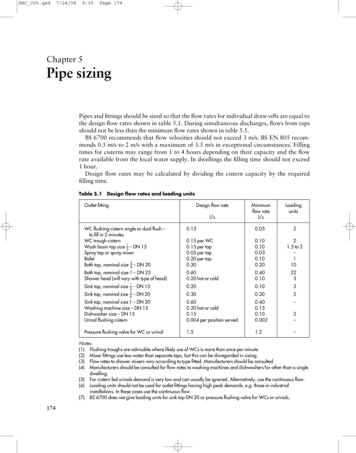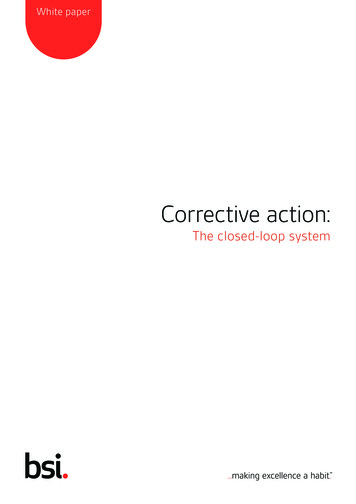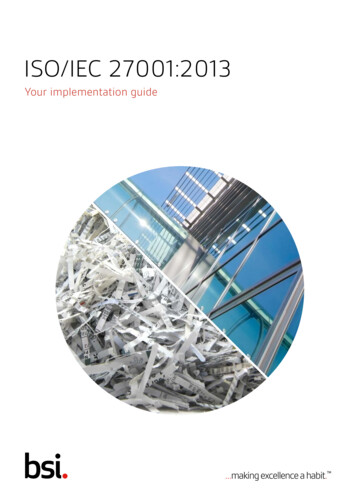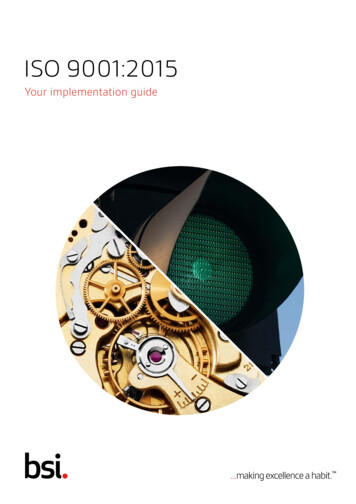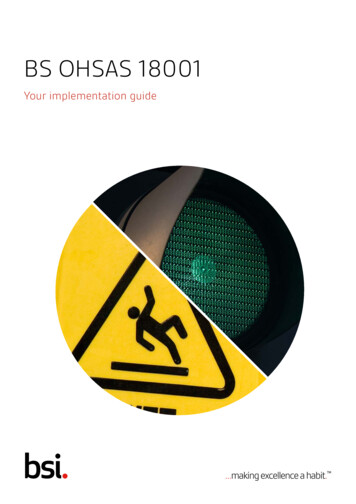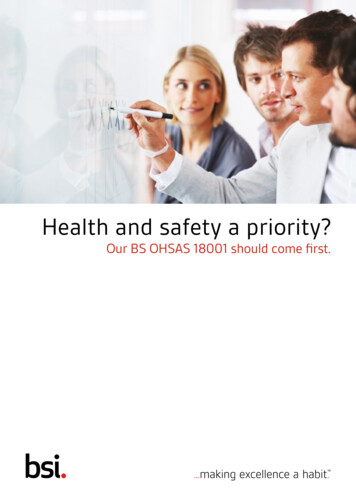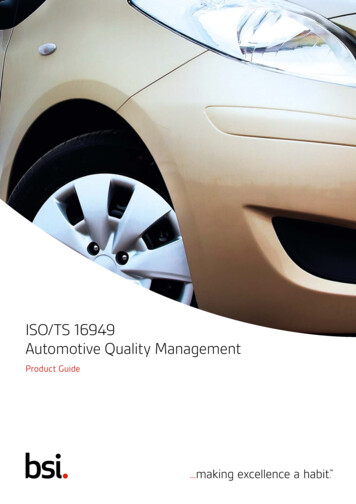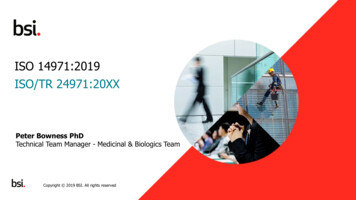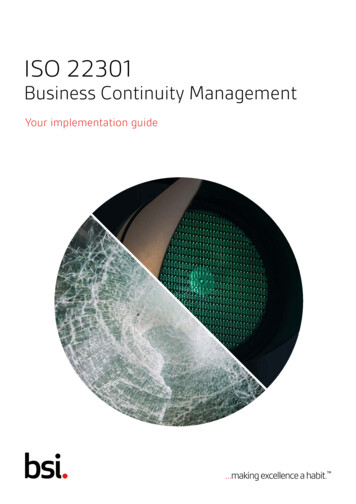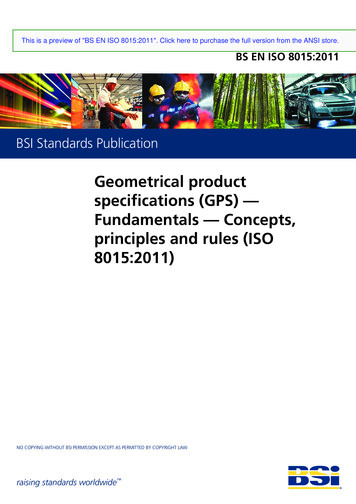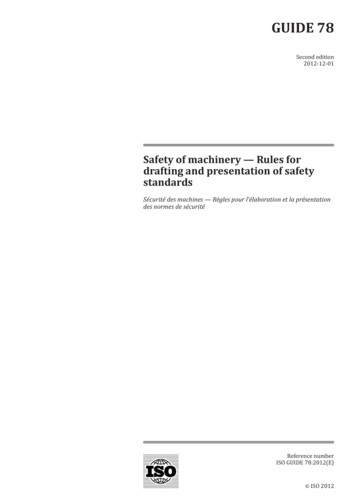
Transcription
GUIDE 78Second edition2012-12-01Safety of machinery — Rules fordrafting and presentation of safetystandardsSécurité des machines — Règles pour l’élaboration et la présentationdes normes de sécuritéReference numberISO GUIDE 78:2012(E) ISO 2012
ISO GUIDE 78:2012(E) COPYRIGHT PROTECTED DOCUMENT ISO 2012All rights reserved. Unless otherwise specified, no part of this publication may be reproduced or utilized in any form or by anymeans, electronic or mechanical, including photocopying and microfilm, without permission in writing from either ISO at theaddress below or ISO’s member body in the country of the requester.ISO copyright officeCase postale 56 CH-1211 Geneva 20Tel. 41 22 749 01 11Fax 41 22 749 09 47E-mail copyright@iso.orgWeb www.iso.orgPublished in Switzerlandii ISO 2012 – All rights reserved
ISO GUIDE 78:2012(E) Contents PageForeword. ivIntroduction.v123456Scope. 1Normative references. 1Terms and definitions. 1General principles. 34.1All safety standards. 3Type-B standards. 34.24.3Type-C standards. 44.4Need for a type-B standard. 64.5Deviations in a type-C standard. 6Principles to be considered before and during drafting process. 65.1General. 65.2Determination of necessity for standardization and/or revision. 6Definition of scope. 75.35.4Identification of hazards, hazardous situations or hazardous events. 7Estimation and evaluation of risk(s) generated by hazard(s). 75.55.6Identification of risk reduction objectives. 85.7Determination of safety requirements and/or protective/risk reduction measures foreliminating hazards and/or limiting risks. 85.8Verification of compliance with safety requirements and/or protective/riskreduction measures. 8Format of a safety standard. 9General. 96.16.2Foreword . 9Introduction . 96.36.4Scope . 106.5Normative references . 11Terms and definitions [symbols and abbreviated terms] . 116.66.7Safety requirements and/or protective/risk reduction measures . 12Verification of the safety requirements and/or protective/risk reduction measures .136.86.9Information for use . 146.10 Annexes. 15Annex A (normative) Procedure to be followed if type-B standards do not exist.16Annex B (informative) Model format of a type-C International Standard.17Bibliography. 21 ISO 2012 – All rights reserved iii
ISO GUIDE 78:2012(E) ForewordISO (the International Organization for Standardization) is a worldwide federation of national standardsbodies (ISO member bodies). The work of preparing International Standards is normally carried outthrough ISO technical committees. Each member body interested in a subject for which a technicalcommittee has been established has the right to be represented on that committee. Internationalorganizations, governmental and non-governmental, in liaison with ISO, also take part in the work.ISO collaborates closely with the International Electrotechnical Commission (IEC) on all matters ofelectrotechnical standardization.International Standards are drafted in accordance with the rules given in the ISO/IEC Directives, Part 2.Draft Guides adopted by the responsible Committee or Group are circulated to the member bodies forvoting. Publication as a Guide requires approval by at least 75 % of the member bodies casting a vote.Attention is drawn to the possibility that some of the elements of this document may be the subject ofpatent rights. ISO shall not be held responsible for identifying any or all such patent rights.ISO Guide 78 was prepared by ISO/TC 199, Safety of machinery, on behalf of the ISO TechnicalManagement Board (TMB).In addition to a number of editorial changes, the main revisions with respect to the previous edition(ISO Guide 78:2008) are as follows:— updating of references and their associated requirements with regard to ISO 12100 and theISO/IEC Directives, Part 2;— addition of a further question to the check list to be used to determine the necessity for standardizationand/or revision [5.2, question e)];— extension of the minimum statement to be given in the Introduction of type B- and type C- standardsby a general notice concerning the document’s relevance, in particular, for those stakeholder groupsrepresenting the market players with regard to machinery safety (6.3.2 and 6.3.3);— addition of the term “risk reduction measure” as a synonym to the term “protective measure”throughout the document;— replacement of the term “optional element” by “conditional element” and “compulsory element” by“mandatory element” in accordance with the latest edition of the ISO/IEC Directives, Part 2;— change in the title of Annex A;— addition of Annex D concerning significant technical changes between a standard and its previousedition, to be added in those cases where the significant technical changes are not already stated inthe Foreword.iv ISO 2012 – All rights reserved
ISO GUIDE 78:2012(E) IntroductionAs a response to the increased global trade in machinery, the relevant ISO Technical Committees haveundertaken publication of a series of related machinery safety standards. It has thus been necessary todevelop rules for the preparation, drafting and presentation of such safety standards, supplementing theISO/IEC Directives, Part 2, which sets out general principles and requirements for all International Standards.This Guide provides those rules. It is intended for use by Technical Committees writing type-B andtype-C standards in the field of safety of machinery (as defined in 3.2 and 3.3). It both makes use of, andrefers to, the principles and concepts established in ISO 12100, and also takes into account, as far aspossible, ISO/IEC Guide 51.International Standards prepared according to this Guide are intended as a means for supportingnational or regional technical regulations (for example, legislation) for machinery safety according tothe principles of UNECE Recommendation L. In order that machinery safety standards be able to supportthese technical regulations, the drafting of the standards can necessitate compliance with specificrequirements additional to this Guide, in as far as any such additional requirements are accepted by ISOas not contradicting the content of this Guide. For example, in order to support European legislation, theGuidelines for the implementation of the agreement on technical co-operation between ISO and CEN (ViennaAgreement) are additionally applicable. ISO 2012 – All rights reserved v
GUIDE ISO GUIDE 78:2012(E)Safety of machinery — Rules for drafting and presentationof safety standards1 ScopeThis Guide presents rules for the drafting and presentation of International Standards dealing withmachinery safety and their revisions, primarily to achieve consistency and acceptable quality of thevarious standards to be prepared.It also gives requirements on the criteria for the selection of new work items and for procedures toprepare, produce or revise standards in an efficient and effective way.This Guide gives requirements that are additional to the ISO/IEC Directives, Part 2, when this is necessaryowing to the special requirements of machinery safety standards.This Guide is primarily intended for the drafting of type-C standards. It is also applicable to the draftingof type-B standards; however, the foreseeable variation in the format of these standards preventsgeneral application. When its requirements are specific to type-B standards, this is indicated.2 Normative referencesThe following documents, in whole or in part, are normatively referenced in this document and areindispensable for its application. For dated references, only the edition cited applies. For undatedreferences, the latest edition of the referenced document (including any amendments) applies.ISO 12100:2010, Safety of machinery — General principles for design — Risk assessment and risk reductionISO/IEC Directives, Part 2:2011, Rules for the structure and drafting of International Standards3 Terms and definitionsFor the purposes of this document, the terms and definitions given in the ISO/IEC Directives, Part 2, andISO 12100, and the following apply.3.1type-A standardbasic safety standardstandard giving basic concepts, principles for design and general aspects that can be applied to machineryNote 1 to entry: See ISO 12100:2010, Introduction.3.2type-B standardgeneric safety standardstandard dealing with one safety aspect or one type of safeguard that can be used across a widerange of machineryNote 1 to entry: See ISO 12100:2010, Introduction.3.2.1type-B1 standardtype-B standard on particular safety aspects (for example, safety distances, surface temperature, noise)Note 1 to entry: See ISO 12100:2010, Introduction. ISO 2012 – All rights reserved 1
ISO GUIDE 78:2012(E) 3.2.2type-B2 standardtype-B standard on safeguards (for example, two-hand control devices, interlocking devices, pressuresensitive devices, guards)Note 1 to entry: See ISO 12100:2010, Introduction.3.3type-C standardmachine safety standardstandard dealing with det
ISO 12100:2010, Safety of machinery — General principles for design — Risk assessment and risk reduction ISO/IEC Directives, Part 2:2011, Rules for the structure and drafting of International Standards 3 Terms and definitions For the purposes of this document, the terms and definitions given in the ISO/IEC Directives, Part 2, and ISO 12100, and the following apply. 3.1 type-A standard .

